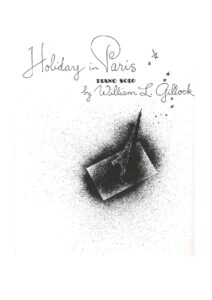Come join us now, and enjoy playing your beloved music and browse through great scores of every level and styles!
Can’t find the songbook you’re looking for? Please, email us at: sheetmusiclibrarypdf@gmail.com We’d like to help you!
Table of Contents
Valse Étude – William Gillock Educational Piano Solo sheet music, Noten, partitura, partition #smlpdf
Best Sheet Music download from our Library.

Contents List download:
Please, subscribe to our Library.
If you are already a subscriber, please, check our NEW SCORES’ page every month for new sheet music. THANK YOU!

Who was William Gillock?
William L. Gillock (July 1, 1917 – September 7, 1993) was an American music educator noted for his many pedagogical piano compositions. Because of the melodic strength of his music, he has sometimes been called “the Schubert of children’s composers”.
Gillock wrote over 300 pieces of pedagogical piano music, brief works with engaging titles and in many different historic and geographic styles. They are still widely available in modern editions, and regularly included in collections of graded pieces issued by the music examination boards.
His most productive period as a composer was between 1956 and 1969. Notable collections include the three volumes of New Orleans Jazz Styles, the eight volume (51 pieces) Accent on series (such as Accent on Duets, Accent on Solos and Accent on the Seasons), and the multi-volume Piano All the Way method.
More extended works include the four movement Little Suite in Baroque Style, which provides an introduction to contrapuntal playing (unusual in early-level pieces) and might be used as a bridge to Handel’s keyboard suites. Similarly (although for more advanced players) Gillock composed the three movement Sonatine in Classic Style (1963), and the Lyric Preludes in Romantic Style (24 pieces in all keys, 1958).
Well-known individual short pieces, mostly for beginning and intermediate players, include Aeolian Harp, Autumn is Here, Carnival in Rio (originally for two pianos), the impressionistic Fountain in the Rain (1960, said to have been his best-selling composition), Goldfish (1964), Happy Holiday, Holiday in Spain, New Orleans Nightfall, On a Paris Boulevard, and The Prowling Pussy Cat.
Few composers have impacted students and piano teachers across the globe as much as Gillock did. More than 30 years after his passing, his compositions are still in wide use today, appearing on state and national repertoire lists across the country, the ABRSM Exam syllabus and in Japan, where he is beloved, to name a few. The late Lynn Freeman Olson observed “the Gillock name spells magic to teachers around the world,” and Martha Hilley of the University of Texas wrote in her article about Gillock, published in 1993: “Teachers knew there was no question of whether to purchase his music; they simply bought it, took it home, and taught it; and student interest and success were almost assured.”1
What was true then, still rings true today. Gillock’s music simply has the ingredients of being instantly appealing and musically gratifying for the student. What greater legacy could any pedagogical composer desire? But that isn’t where Gillock’s appeal or legacy ends. He was equally renowned for his astute abilities as an adjudicator and for the hundreds of inspirational workshops he gave for Willis Music Company. For those who knew him personally, he was cherished for who he was as a person as much as he was for his music.
Without exception, everyone with whom I’ve had a conversation about William Gillock describes him as the gentlest person you would ever want to meet, and said he made you feel as if you were the most important person in the room. Glenda Austin, whom he mentored as a young teacher, described him as being patient, generous, charismatic and kind. Others said he was inquisitive, intelligent, humble, even self-deprecating and never one to put on airs. In my personal view, he was always a gentleman, elegant and refined. He took time to linger, whether it was with you or in his music, and wanted you to share in the beauty of whatever commanded his attention.
Browse in the Library:
Or browse in the categories menus & download the Library Catalog PDF:
